Timeline of the life of Charles Robert Darwin
by Janet Browne & John van Wyhe
By far the most detailed timeline/itinereary of Darwin's life- with over 500 entries- is in Darwin: A Companion (2021) - now expanded and available in Darwin Online: Itinerary.
1809 12 February Born in Shrewsbury, England, the son of Robert Waring Darwin and Susannah, nee Wedgwood. 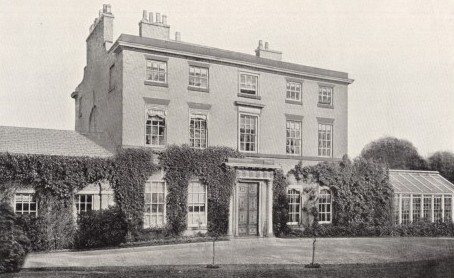
1813 In the summer goes to Gros, near Abegele, in Wales, for sea-bathing with family, some of his earliest recollections coming from this.
1814-1816 No information about his being away from The Mount.
1817 Attends day school in Shrewsbury run by George Case, Unitarian minister. His mother dies.
1818 In June goes to Samuel Butler's school at Shrewsbury as a boarder (stayed 7 years). Butler was the grandfather of Samuel Butler (1835-1902) the science writer and critic of Darwinism.
1819 July Summer holiday at Plas Edwards, Towyn, N. Wales.
1820 July went on riding tour with Erasmus brother to Pistyll Rhayader, N. Wales.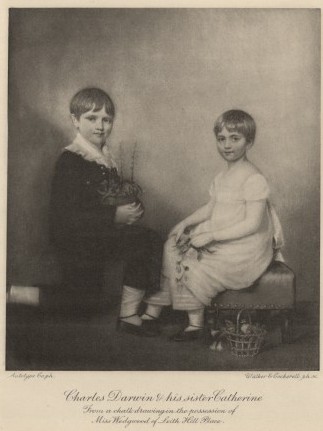
1822 June went to Downton, Wilts with sister Caroline. July went to Montgomery & Bishop's Castle, Shropshire with sister Susan.
1824 Visits Llandudno, Wales, with school friend John Price.
1825 17 June taken away early from Shrewsbury School by his father. On 22 October matriculates with his brother Erasmus at the University of Edinburgh. Registers for medical courses. First lecture on 26 October. Lodged at 11 Lothian St.
1826 June takes a walking tour in North Wales. In the winter meets Dr Robert Grant (1793-1874), naturalist and Lamarckian, and examines marine animals. 10 November elected to Plinian Society.
1827 27 March reads papers on marine animals to Plinian Society. Leaves Edinburgh in April. Visits Belfast and Dublin in spring. Visited Paris in May with Wedgwood cousins, his only time in France. This summer he spends much time at Woodhouse, the home of the Mostyn Owens. On 15 October is admitted to Christ's College, University of Cambridge, but does not move there until January 1828. Reads for an ordinary degree, the usual preliminary for theological training (which was never undertaken).
1828 Becomes friendly with his cousin William Darwin Fox at Christ's. Is a keen entomologist and collector of beetles. Attends John Stevens Henslow's botany classes.
1829 Travels to Wales to collect insects with entomologist Frederick William Hope. Spends Michaelmas term in Cambridge. Entomologises with Leonard Jenyns; Friday evenings at Henslow's. July his name appears in Stephens' Illustrations of British Entomology. December three weeks in London with Erasmus. Entomological visits to Hope and Stephens.
1830 January in Cambridge, reading for 'Little Go'. August collects insects in North Wales with Hope. March passes 'Little Go'. August entomological tour in North Wales with Hope and T. C. Eyton.
1831 Passes his BA examinations on 22 January without honours and remains at Cambridge for a further two terms to fulfill residence requirement. Spends much time with Henslow, and in August accompanies Adam Sedgwick, Professor of Geology, on his annual field trip to Wales. In August he returns to Shrewsbury from Wales to find a letter from Henslow inviting him to join the Beagle voyage. Darwin's father objects, but his uncle, Josiah Wedgwood II, persuades him otherwise. Meets Captain Robert FitzRoy (1805-65) and makes preparations for the voyage. Begins Beagle diary. After two false starts, the ship leaves Plymouth on 27 December.
[For the only complete day-by-day itinerary of the Beagle voyage click here]
1832 16 January, Darwin makes his first landing on a tropical shore at St Jago, Cape Verde Islands. Field notebooks begin to be used. From February 1832 to May 1834 the Beagle surveys the east coast of South America. In December arrives in Tierra del Fuego.
1833 March, Beagle visits Falkland Islands. From April to July around Maldonado, August to December in Rio Negro and Montevideo.
1834 Early part of the year is spent surveying in Tierra del Fuego and another visit to the Falkland Islands. April to May Darwin and FitzRoy make an inland expedition along the River Santa Cruz. Repeated ports of call in Tierra del Fuego, eventually leaving the Straits of Magellan in June. From June 1834 to September 1835 the Beagle surveys the west coast of South America. Calls at Chiloé Island. From end of July to November Darwin resides in Valparaiso, returns to Chiloé until February 1835.
1835 Spends February in Valdivia and early March in Concepcion, makes long excursion northwards from March to September, calling at Copiapo, Iquique and Callao. Beagle departs Lima on 7 September for the Galapagos Archipelago. Darwin spends 16 September to 20 October exploring the archipelago, 15-26 November in Tahiti, 21-30 December in New Zealand. December Henslow prints extracts from his letters. 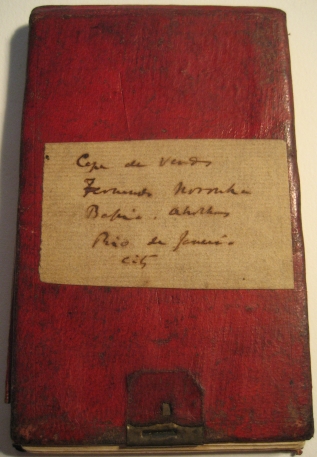
1836 Beagle calls at Sydney in January, Hobart in February, Cocos and Keeling Islands in April, followed by Mauritius. Visits Cape of Good Hope from 31 May to 18 June. Writes first article to be published with Fitzroy. The ship makes way across Atlantic ocean calling at St Helena and Ascension Islands in July. Returns briefly to Brazil in August to check some readings. Calls at Azores in September. 2 October, Beagle drops anchor at Falmouth, England, and on 4 October Darwin returns home to Shrewsbury. Begins to publish scientific papers.
1836-1837 16 December to 6 March 1837 lives in lodgings in Fitzwilliam Street, Cambridge.
1837 In March takes lodgings in 36 Great Marlborough Street, London. Gives papers at the Geological Society of London. Arranges for his Beagle specimens to be identified. Begins publication of The Zoology of the Voyage of the Beagle (1838-43). Becomes friendly with the geologist Charles Lyell. The naturalist John Gould identifies his bird specimens. In July opens his first notebook on the transmutation of species.
1838 Works intensely on a variety of natural history and geological topics. Finishes a paper on the geology of Glen Roy in Scotland. On 28 September he read 'for amusement' T. R. Malthus Essay on the Principle of Population (1798). 'Here, then, I had at last got a theory by which t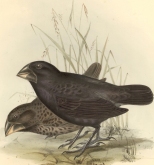 o work' (Autobiography). On 11 November proposes marriage to his cousin Emma Wedgwood (1808-96). In the last weeks of the year moves to a house in Gower Street, London.
o work' (Autobiography). On 11 November proposes marriage to his cousin Emma Wedgwood (1808-96). In the last weeks of the year moves to a house in Gower Street, London.
1839 Marries Emma Wedgwood on 29 January. Publishes Journal of Researches, later known as Voyage of the Beagle. Elected a Fellow of the Royal Society. First child, a son William, is born. He and Emma eventually have ten children, seven of whom reach adulthood. Disseminates Questions about the breeding of animals.
1840 Publishes paper On the formation of mould. The book on this subject would only be published in 1881.
1841 Writes cousin Fox that, when finished with current projects, will write a book to be entitled 'Varieties & Species'. Publishes some geological articles such as On the distribution of erratic boulders.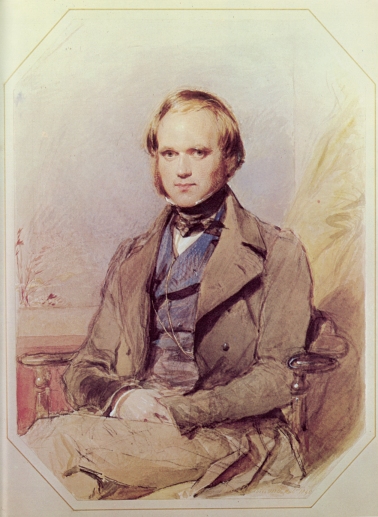
1842 Makes a short geological excursion in Wales. Settles with his wife and young family in Down House, in the village of Downe in Kent. Publishes The structure and distribution of coral reefs. On a visit to his wife's family home, Maer in Staffordshire, makes a brief pencil sketch of his theory of 'descent with modification'.
1843 Building works at Down House. Continues work on volcanic islands.
1844 Expands sketch into a longer Essay. Writes a memorandum to Emma Darwin requesting that this essay should be published if he should die unexpectedly, giving the names of several friends who would serve as possible editors. Publishes Geological Observations on the Volcanic Islands visited during the Voyage of HMS Beagle.
1845 Expands and revises Journal of Researches for a second edition. Begins a lifelong relationship with the London publishing house of John Murray.
1846 Publishes Geological Observations on South America. October begins work on barnacles.
1847 Continues work on barnacles. Visits Shrewsbury February to March, June British Association for Advancement of Science at Oxford. Later returns home in July. 22 October to 5 November in Shrewsbury.
1848 November, his father Robert Waring Darwin dies. Goes to Shrewsbury for the funeral but arrives too late to attend.
1849 March to June the whole family reside in Malvern Wells so that he can take the water cure. Publishes chapter on Geology in A manual of scientific enquiry; prepared for the use of Her Majesty's Navy.
1850 Working on barnacles. 11-18 June visits Malvern Wells.
1851 March takes oldest daughter Annie to Malvern where she dies of fever on 23 March, aged ten. In July the family visits the Great Exhibition in London's Hyde Park. Publishes the first of two volumes on barnacles, A Monograph on the sub-class Cirripedia, and the first of two volumes on fossil barnacles, A Monograph on the fossil Lepadidae.
1852 Spent year working on barnacles (Sessile Cirripedes). 24 March to Rugby for a day and thence to Shrewsbury returning home 1 April. 11 September to Leith Hill Place to visit Josiah Wedgwoods, returning home on 16th. 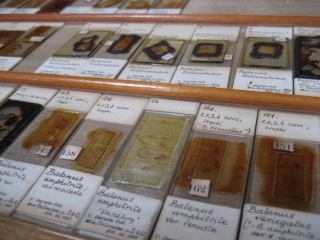
1853 Spent 'Whole year preparing M.S of Sessile Cirripedes for press.'
1854 Publishes concluding volumes on barnacles, A Monograph on the sub-class Cirripedia, and A Monograph on the fossil Balanidae and Verrucidae. Immediately begins full-time work on species.
1855 'March & April. Employed chiefly in comparing seeds—trying experiments in salting seeds.— & reading.—'
1856 On Charles Lyell's advice begins writing up his views for a projected big book called 'Natural Selection'.
1857 Whole year spent writing chapters of species book.
1858 In June receives a letter from Alfred Russel Wallace who is collecting specimens in Indonesia. Wallace encloses an essay on species and varieties that mirrors Darwin's own theory of natural selection. 'I never saw a more striking coincidence. ..If Wallace had my MS sketch written out in 1842 he could not have made a better short abstract!' Baby Charles dies of scarlet fever on 28 June. Extracts from Darwin and Wallace's writings presented by Charles Lyell and Joseph Hooker at the Linnean Society of London on 1 July. Neither Darwin nor Wallace attend. Papers published in Journal of the Proceedings of the Linnean Society of London. Visits Isle of Wight where he begins an 'abstract' of his views for publication.
1859 On the Origin of Species by means of Natural Selection, or the Preservation of Favoured Races in the Struggle for Life is published in London on 24 November by John Murray. On publication day Darwin is taking the water cure in Ilkley, Yorkshire.
1860 Publishes 2nd edition of Origin. Foreign editions appear. Begins work on Variation book.
1861 Continued work on Variation book. Published 3rd edition of Origin. Began work on Orchid book.
1862 Begins to grow a beard after an episode of ill health. Publishes On the Various Contrivances by which British and foreign Orchids are fertilised by Insects, and On the Good Effects of Intercrossing. Meets Alfred Russel Wallace on his return from Indonesia.
1863 Seriously ill, consults many medical men about his symptoms. Ill health continues until spring 1866.
1864 In November awarded the Copley medal of the Royal Society of London, its highest scientific honour.
1865 Publishes an article on climbing plants in the journal of the Linnean Society of London, 'On the Movements and Habits of Climbing Plants'. Later published as a book in 1865.
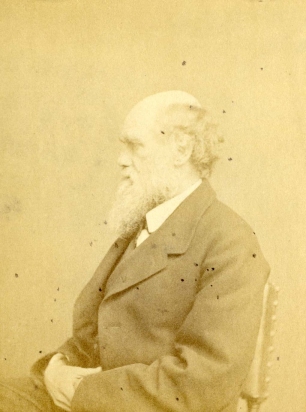 1866 Publishes 4th edition of Origin. Continued work on Variation book. Sits for the portrait, right.
1866 Publishes 4th edition of Origin. Continued work on Variation book. Sits for the portrait, right.
1867 Completes Variation MS. Distributes several Queries about expression.
1868 July Visits Isle of Wight and meets Alfred Lord Tennyson and Julia Margaret Cameron. Is photographed by Cameron. Publishes The Variation of Animals and Plants Under Domestication.
1869 Publishes 5th edition of Origin. Continues work on descent of man.
1870 Whole year working on descent of man. Various visits to relatives.
1871 Publishes The Descent of Man, and Selection in relation to Sex. Engages in dispute with St George Mivart, adds a new chapter to sixth edition of Origin of Species to rebut Mivart's claims. Daughter Henrietta marries Richard Litchfield and moves to Bryanston Street in London where Darwin becomes a regular visitor.

Caricatures of Darwin appear for the first time in response to Descent of man. See the world's largest collection of these caricatures here. 

1872 Publishes 6th edition of Origin. 13 February to 21 March rents London holiday house at 9 Devonshire St. In October takes a family holiday in a rented house in Sevenoaks, Kent. Is impressed with the veranda and on returning to Down House builds one there. Publishes The Expression of the Emotions in Man and Animals.
1873 Attends a soiree at George Eliot's house. Worked on climbing plants and 2nd edition of Descent of man.
1874 A séance is held at his brother's house in January but Darwin does not attend. 'The Lord have mercy on us all, if we have to believe in such rubbish.' 2d editions of Descent and Coral Reefs published.
1875 Publishes Insectivorous Plants. Gives evidence to the Royal Commission on Subjecting Live Animals to Experiments. Sits to the portrait painter Walter William Ouless, for the family. A copy later made by Ouless for Christ's College, Cambridge, etched by Paul Rajon. 'I look a very venerable, acute melancholy old dog'.
1876 During the summer begins to write an autobiographical memoir for his children and future grandchildren. 'I know that it would have interested me greatly to have read even so short and dull a sketch of the mind of my grandfather written by himself, and what he thought and did, and how he worked.' This memoir published in edited form in Francis Darwin's Life and Letters of Charles Darwin (1887) Publishes The Effects of Cross and Self Fertilisation in the Vegetable Kingdom. In September Darwin's first grandchild is born to Francis and Amy Darwin. Amy dies in childbirth and Francis goes to live with his parents at Down House with the baby, Bernard Darwin. Francis becomes Darwin's secretary and botanical assistant.
1877 Awarded Honorary LLD by Cambridge University. Publishes The Different Forms of Flowers on Plants of the same Species and 'A biographical sketch of an Infant' in the journal Mind which was written up from notes made in 1839-41 on his firstborn, William Darwin.
1878 'The whole of this last year [working on] on the circumnutating Movements of plants & bloom.'
1879 In August takes a family holiday in Coniston in the Lake District. Meets John Ruskin. Publishes a biographical study of his grandfather, Erasmus Darwin. Translated from the German by W.S. Dallas, with a preliminary notice by Charles Darwin, followed by bitter attacks by Samuel Butler who accuses Darwin of plagiarism. Is painted in oils for the Cambridge Philosophical Society by William Blake Richmond, dismissed by Emma Darwin as 'quite horrid, so fierce & so dirty'.
1880 Publishes The Power of Movement in Plants…Assisted by Francis Darwin.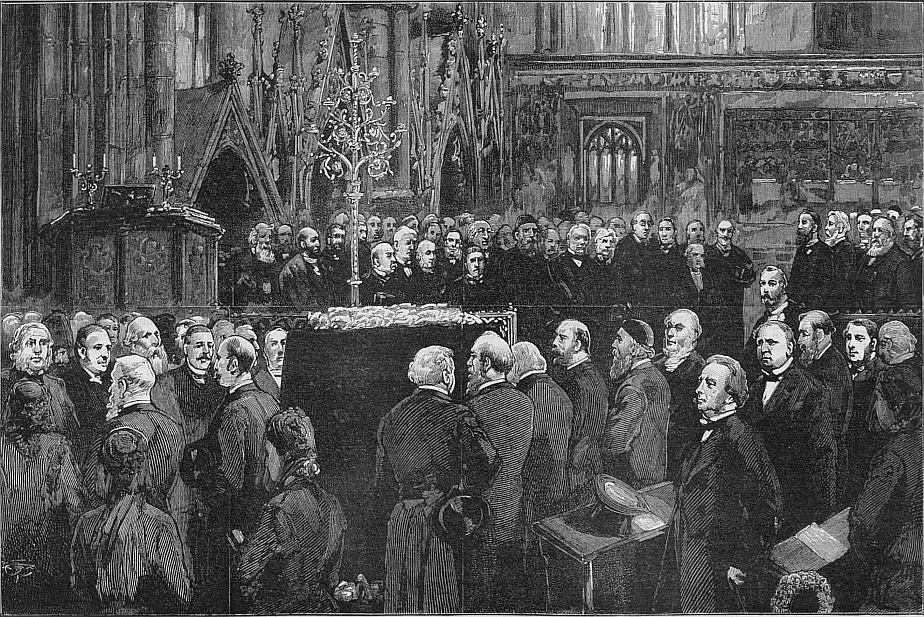
1881 July, takes another holiday in the Lake District, based in Ullswater. In August his brother Erasmus dies, and is buried in Down churchyard. Publishes The Formation of Vegetable Mould through the Action of Worms, with observations on their Habits. Bestows money to Kew Gardens for publication of Index Kewensis. Arranges a civil list pension for Wallace. Defends right of scientists to experiment on live animals.
1882 Dies 19 April, aged seventy-three. Buried in Westminster Abbey, 26 April. See the most detailed introduction of his funeral online here. See his last will and testament here.
See also the itinerary in Freeman, Charles Darwin: A companion. 2d online ed. 2007, compiled by Sue Asscher, p. 98, and, Darwin's personal 'Journal' (1809-1881). Introduction Text CUL-DAR158.1-76 and Emma Darwin's diaries.
John van Wyhe
RN12






